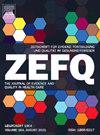Analyse der Zielgruppen in der Weiterbildung Allgemeinmedizin: Ergebnisse einer Kohortenstudie im Kompetenzzentrum Weiterbildung Baden-Württemberg (KWBW)
IF 1.7
Q4 HEALTH POLICY & SERVICES
Zeitschrift fur Evidenz Fortbildung und Qualitaet im Gesundheitswesen
Pub Date : 2025-09-01
DOI:10.1016/j.zefq.2025.06.004
引用次数: 0
Abstract
Background
Residents in Family Medicine (FM) decide on their FM training pathway directly at the start of their career (“direct entry”), in the course of their further training (“advanced entry”), or switch to FM from another medical specialty (“lateral entry”). The aim of this study is to characterize the participants of the Competence Center for Postgraduate Medical Training in Baden-Württemberg (Kompetenzzentrum Weiterbildung Baden-Württemberg, KWBW) in target groups (target audience).
Methods
An ongoing cohort study has been conducted at the KWBW since 2016. All FM trainees receive a self-designed questionnaire with 54 items on socio-demographic data and previous professional experience when they enter the program. Between 11/2020 and 12/2021, an additional questionnaire containing 21 items on motivation for FM training was used. The data was analyzed descriptively and semi-qualitatively.
Results
Of 929 new trainees, n = 883 took part in the survey (response rate 95.2 %). Of these, 50.9 % entered the program at an advanced stage of their training (AEs, n = 450), 24.5 % were direct entrants (DEs, n = 216), and 23.8 % were lateral entrants (LEs, n = 210). AEs more likely had children than DEs (p < 0.001), and they were more frequently female than DEs or LEs (p = 0.02). The motivators for training in FM included: the continuity of FM care for patients, the compatibility of career and care work, the broad mix of patients, and difficult working conditions in hospitals.
Discussion and conclusions
There were life-stage-specific differences between the three subgroups entering the KWBW. The motivation for FM Spezilisation also differs between DEs, AEs and LEs. A strict separation of learners into DEs, AEs and LEs contradicts competence- and motivation-enhancing peer learning.
The differentiation of FM trainees into AEs, DEs and LEs helps understand different life circumstances and learning needs and fosters target group-specific support. Internal differentiation in the program enables target group-specific and learner-centered offers and thus increases the attractiveness of a Competence Center for Postgraduate Medical Training for all FM trainees.
[家庭医学专业培训目标受众分析:研究生医学培训能力中心队列研究结果]。
背景:家庭医学(FM)的住院医生在他们的职业生涯开始时直接决定他们的FM培训路径(“直接进入”),在他们的进一步培训过程中(“高级进入”),或者从其他医学专业切换到FM(“横向进入”)。本研究的目的是确定巴登-符腾堡州研究生医学培训能力中心(Kompetenzzentrum Weiterbildung baden -符腾堡州,KWBW)目标群体(目标受众)的参与者特征。方法:自2016年以来,在KWBW进行了一项正在进行的队列研究。所有FM学员在进入项目时都会收到一份自行设计的问卷,其中包含54项社会人口统计数据和以前的专业经验。在2020年11月至2021年12月期间,使用了一份额外的问卷,其中包含21个关于FM培训动机的问题。对数据进行了描述性和半定性分析。结果:929名新学员中,n = 883人参加了调查,回复率为95.2% %。其中,50.9 %进入项目处于高级阶段的培训(AEs, n = 450),24.5 %直接进入者(DEs, n = 216)和23.8 %是横向进入者(莱斯,n = 210)。讨论和结论:进入KWBW的三个亚组之间存在生命阶段特异性差异。FM细化的动机在DEs、ae和le之间也有所不同。将学习者严格划分为DEs, ae和LEs与能力和动机增强的同伴学习相矛盾。将FM学员区分为ae、de和le,有助于了解不同的生活环境和学习需求,并促进针对目标群体的支持。该方案的内部差异化使得提供针对特定目标群体和以学习者为中心的服务,从而增加了研究生医学培训能力中心对所有FM学员的吸引力。
本文章由计算机程序翻译,如有差异,请以英文原文为准。
求助全文
约1分钟内获得全文
求助全文
来源期刊

Zeitschrift fur Evidenz Fortbildung und Qualitaet im Gesundheitswesen
HEALTH POLICY & SERVICES-
CiteScore
1.90
自引率
18.20%
发文量
129
 求助内容:
求助内容: 应助结果提醒方式:
应助结果提醒方式:


